Intel's Architecture Day 2018: The Future of Core, Intel GPUs, 10nm, and Hybrid x86
by Dr. Ian Cutress on December 12, 2018 9:00 AM EST- Posted in
- CPUs
- Memory
- Intel
- GPUs
- DRAM
- Architecture
- Microarchitecture
- Xe
Changing How Chips are Made: 3D Packaging with FOVEROS
Anyone who has followed any amount of chip design in semiconductors should well-aware that most of the CPUs and SoCs in production today are based on monolithic dies – single pieces of silicon the have all what is needed inside, before being placed on a package and into a system. While rarer, there are multi-chip packages, were multiple chips go in one package with a shared connection. Beyond this we have seen interposers or embedded bridges designed to bring different chips together with high-speed interconnects. Now Intel is ready to bring 3D stacking into the mass market.
One of the biggest challenges in modern chip design is minimizing die area. A small die decreases costs – typically power too – and can make it easier to implement in a system. When it comes down to extracting performance however, we are at the limits of scale – one of the downsides of big monolithic dies, or even multi-chip packages, is that memory is too far away. Intel today is now ready to talk about its Foveros technology, which involves active interposers in small form factors to bring differentiated technologies together.
Foveros: It’s Greek for Awesome, Apparently
The way Raja introduced this technology started with discussing process technologies. Intel has for many years/decades been focused on high performance process nodes, trying to extract as much as possible from its high-performance cores. Alongside this, Intel also runs an IO optimized process node on a similar cadence but more suitable for PCH or SoC-type functions.
The 126x and 127x are the internal numbering systems for Intel’s process node technologies, although they don’t differentiate between BKM updates for the "+" node variants it turns out. But the point here is that Intel already knows that it needs certain process optimizations in place depending on the type of transistors, performance, and power needed. Going forward, Intel is going to be expanding its node base out so it can cover more power and performance points.
So for this example, Raja pulled out the current set of process technologies for 2019. For a manufacturing process, compute has the 1274 process on 10nm, IO has the 1273 process (14nm), while this new special Foveros technology is under P1222. Alongside the manufacturing, Intel will be working on optimizations focusing on the compute aspects of the manufacturing node. There will also be a set of developments for future node technologies, and the final column shows that Intel has path-finding research to look into future technologies and determine what capabilities will be possible on future designs. This sounds pretty much what a company like Intel should be doing, so no argument from me so far. The goal here is that each type of transistor use case can be different, and there isn’t a one-size fits all approach.
One way to assist with this is through chiplets and packaging. By picking the best transistor for the job in each case, whether it is CPU, GPU, IO, FPGA, RF, or anything else, with the correct packaging, it can be put together to get the best optimizations available.
So here’s where Foveros fits in. Foveros is Intel’s new active interposer technology designed as a step above its own EMIB designs for small form-factor implementations, or those with extreme memory bandwidth requirements. For these designs the power per bit of data transferred is super low, however the packaging technology has to deal with the decreased bump pitch, the increased bump density, and also the chip stacking technology. Intel says that Foveros is ready for prime time, and they can produce it at scale.
So this Foveros ‘3D’ packaging just sounds like a silicon interposer, such as what we’ve seen on AMD’s Fiji or NVIDIA’s high-end datacenter GPUs. However Intel is going above what those products are doing by actually making the interposer part of the design. The interposer contains the through-silicon vias and traces required to bring power and data to the chips on top, but the interposer also carries the PCH or IO of the platform. It is, in effect, a fully working PCH, but with vias to allow chips to be connected on top.
The first iteration of this technology is less complicated that the slide above, just using a set of CPU cores attached to the PCH below, but the idea is that a large interposer can have select functions on it and those can be removed from the chips above to save space. This also lets Intel use the different transistor types in different chips – the example we were given uses an interposer built on the 22FFL process node, with a 10nm set of CPUs on the top die. Above this, DRAM is provided in a POP package. Sounds cool, right?
In actual fact, Intel had a Foveros chip or two working in the demo area. These, Intel explained, were hybrid x86 designs that combined a single big Core with four smaller Atom cores on the same 10nm piece of silicon. I’m sure I’ve heard about big.Little before, but I was shocked that Intel is actually going to do it! We managed to take a photo of the block diagram, which Intel removed from its slide deck before sending it out to the press after the presentations. All details on the next page.


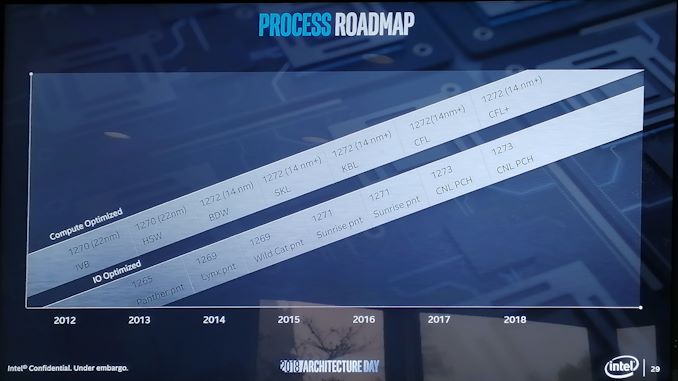
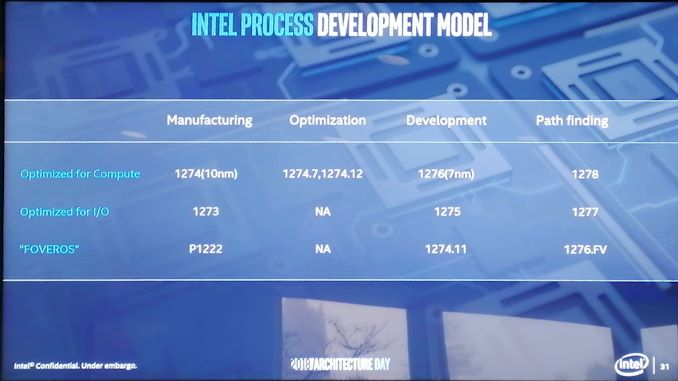
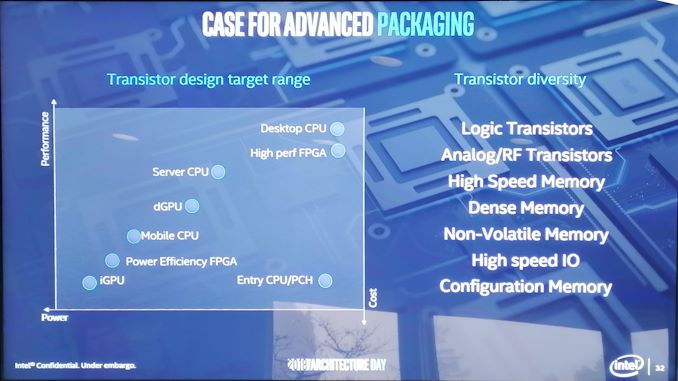
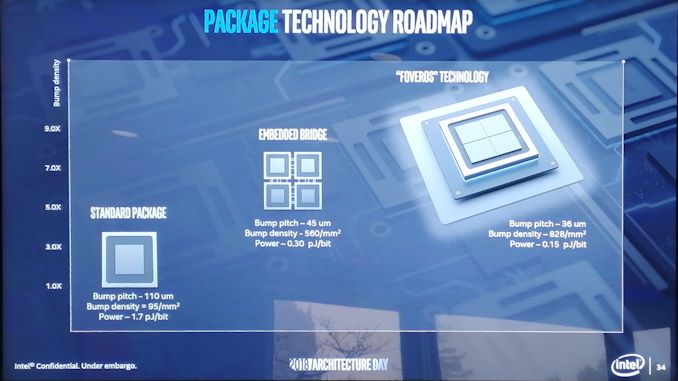
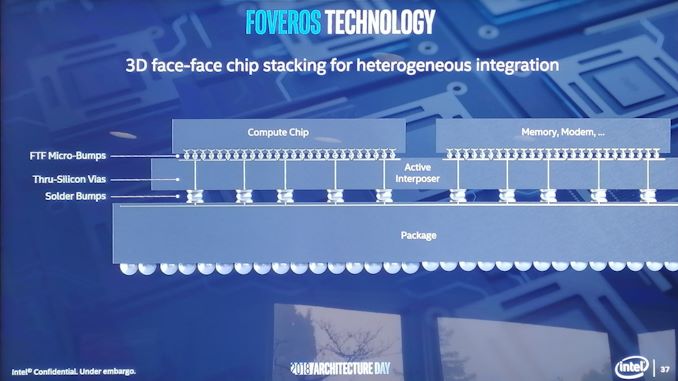
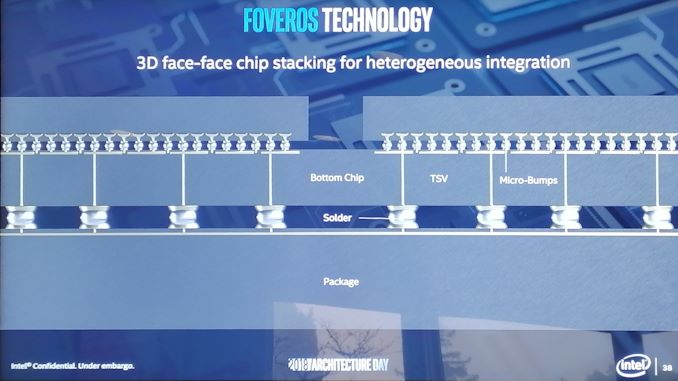








148 Comments
View All Comments
nathanddrews - Wednesday, December 12, 2018 - link
I know the meme about gaming on Intel graphics, but if they implement Adaptive Sync *combined* with some sort of low framerate compensation, it would make gaming on Intel IGP much less hilarious. Can Intel license FreeSync without using AMD GPU inside? I know FreeSync worked on KLG, but that had an AMD GPU.RarG123 - Wednesday, December 12, 2018 - link
Like many of AMD's things, FS's an open standard and royalty free. Anyone can use it.Ryan Smith - Wednesday, December 12, 2018 - link
More specifically, Freesync 1 just AMD's implementation of DisplayPort Adaptive Sync. Intel has to build their own implementation in their display controller and driver stack, but past that all the signaling aspects to the monitor are standardized.Topweasel - Wednesday, December 12, 2018 - link
Ryan, I thought that was reversed, that AMD worked on adding Adaptive Sync into the specs and worked on making sure it's implementation matched what they were doing with Freesync.kpb321 - Wednesday, December 12, 2018 - link
IIRC it's a bit of both. Adaptive Sync was present in the eDP standard for things like laptop monitors or tablets as a power saving feature. AMD brought this to the desktop side of things to use for variable framerates in games and helped the standard bring it over too.edzieba - Wednesday, December 12, 2018 - link
'Adaptive Sync' is effectively the eDP Panel Self Refresh ported over to the full DP spec.drunkenmaster - Wednesday, December 12, 2018 - link
Freesync utilises adaptive sync. Adaptive Sync is the technology on the screen side, a screen must support adaptive sync to be used by Freesync. Freesync is just the AMD side of it. If a adaptive sync capable screen is detected you can turn on freesync in drivers. Adaptive sync was a standard written up and proposed by AMD and given to I forget who it is now, Displayport group direct or to Vesa. They accepted it and implemented it pretty quickly but as with all things standards take a long time for get integrated into the next cycle or two of products.Anyone can use Adaptive sync panels, no one but AMD can use freesync as it's something specific to their hardware and drivers. intel will produce their own specific driver/implementation and just connected to adaptive sync panels in the same way.
porcupineLTD - Wednesday, December 12, 2018 - link
So Intel is going straight to chiplets on interposer, it will be interesting to see if AMD adopts this with Zen 3 or waits until Zen 4. Anyway its nice to see competition doing its job.Alexvrb - Wednesday, December 12, 2018 - link
We don't know yet exactly how much logic Intel is moving to the interposer. It looks awesome for mobile form factors! I think they will face some challenges to bring it to high-TDP desktop solutions, though.ajc9988 - Wednesday, December 12, 2018 - link
http://www.eecg.toronto.edu/~enright/micro14-inter... http://www.eecg.toronto.edu/~enright/Kannan_MICRO4... https://youtu.be/G3kGSbWFig4 https://seal.ece.ucsb.edu/sites/seal.ece.ucsb.edu/... https://www.youtube.com/watch?v=d3RVwLa3EmM&t=...